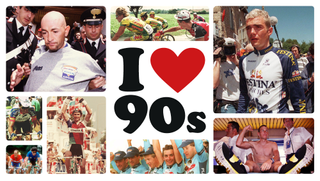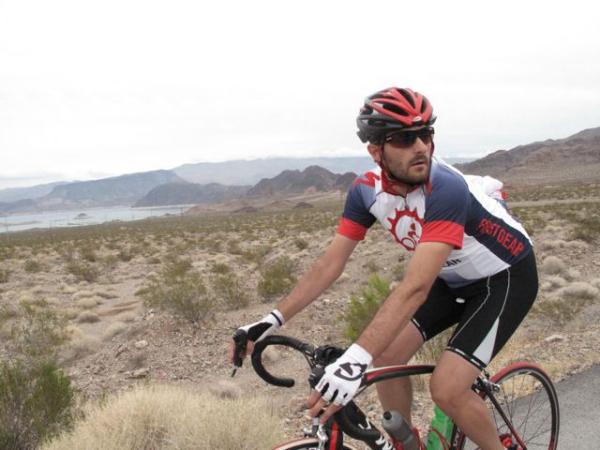I love the 1990s – A look back at cycling's decadent decade
A special series of features and interviews

Professional cycling has experienced some incredible moments during its colourful history but few decades saw the dramatic changes that arrived in the 1990s.
The widespread use of the blood-boosting drug EPO and the subsequent scandals, police raids and controversies changed the sport like never before. Races became faster, with sports doctors replacing soigneurs as the facilitators of a dirty revolution in the peloton. The sport became medically driven like never before, with a rider’s haematocrit as decisive as their natural talent.
Rather than protest, many riders simply adapted to the times and began carrying their own EPO in ice-filled flasks. They injected it at races, sure that they would not be caught by a governing body lacking in both recourse and courage. A few veterans quit in disgust as those in power largely turned a blind eye and took advantage as the sport grew globally like never before.
The racing in the 1990s was often spectacular and dramatic, but it was also surreal and fake. The house of cards eventually came tumbling down when the French police intervened, and the Festina Affair exploded during the 1998 Tour de France. However, it would take another decade to begin to clean up the mess and restore some credibility.
A lost decade?
It would be easy to write the 1990s off as a decade lost to doping. But to mask oneself from cycling history would be just as unjustified. The 1990s most certainly happened, races were won and lost, and results remain on rider palmares. The only pertinent question we are left with is: Where do the 1990s stand in the history of the sport?
To help answer the question, the doubts and this discussion, we’ve created a collection of stories that look back in time. They are first-hand accounts from the riders, managers and journalists who lived through those races, and the difficult choices that had to be made.
Do not be fooled by the iconic typography that accompanies this introduction. This collection of work is not a glorification of cheating and nor is it a whitewash based upon strict morality. We hope the collection of stories will spark a debate about the decade and its place in the history of the sport.
Get The Leadout Newsletter
The latest race content, interviews, features, reviews and expert buying guides, direct to your inbox!
The 1990s were an era of great transformation for cycling. Spurred by its first global superstar in the form of Greg LeMond, cycling came through the late 1980s and professionalised, in parts. Bike innovation led to huge gains regarding design and aerodynamics; internationalisation of teams continued with more and more riders coming to Europe from Australia, eastern Europe and of course the USA.
Technology also played a part, with the arrival of the internet, which helped take the sport from the back pages of European newspapers and niche magazines to the forefront of home dial-up browsers.
The decade that transformed cycling forever
During the next ten days, Cyclingnews will publish a series of features and interviews.
Robert Millar will take us through the 1991 season – a year in which he began to see a huge transformation in performance. William Fotheringham recounts the story of Gianni Bugno’s often forgotten, yet poignant, second World Championship win on the streets of Benidorm in 1992.
Matt Rendell hunts down the diminutive Alvaro Mejia for a rare interview about his brief moment of success at the Motorola team, and Jonathan Vaughters opens up about the landscape and dilemmas faced by every young neo-pro. Alasdair Fotheringham talks to former amateur world champion Danny Nelissen about 1995, and Pro Cycling editor, Ed Pickering, tracks the story of the UCI Hour Record as it built to a crescendo with Chris Boardman’s Superman record of 1996.
French journalist Jean-François Quenet looks back at FDJ - a team started in 1997 and forced to compete against Richard Vireneque’s Festina squad – and now celebrating their 20th year in the sport.
Jeremy Whittle, the author of Bad Blood, looks back at the 1998 Festina Affair, and Stephen Farrand draws the curtain on a dramatic decade with an insight into the day Marco Pantani’s world first fell apart at the 1999 Giro d’Italia.
But first, Barry Ryan interviews Giles Delion - one of the most fascinating characters of the 1990s. The Frenchman may not have the palmares of many of his rivals, but his story is also the story of the 1990s, the decade that saw professional cycling transformed forever.

Thank you for reading 5 articles in the past 30 days*
Join now for unlimited access
Enjoy your first month for just £1 / $1 / €1
*Read any 5 articles for free in each 30-day period, this automatically resets
After your trial you will be billed £4.99 $7.99 €5.99 per month, cancel anytime. Or sign up for one year for just £49 $79 €59

Join now for unlimited access
Try your first month for just £1 / $1 / €1
Daniel Benson was the Editor in Chief at Cyclingnews.com between 2008 and 2022. Based in the UK, he joined the Cyclingnews team in 2008 as the site's first UK-based Managing Editor. In that time, he reported on over a dozen editions of the Tour de France, several World Championships, the Tour Down Under, Spring Classics, and the London 2012 Olympic Games. With the help of the excellent editorial team, he ran the coverage on Cyclingnews and has interviewed leading figures in the sport including UCI Presidents and Tour de France winners.

